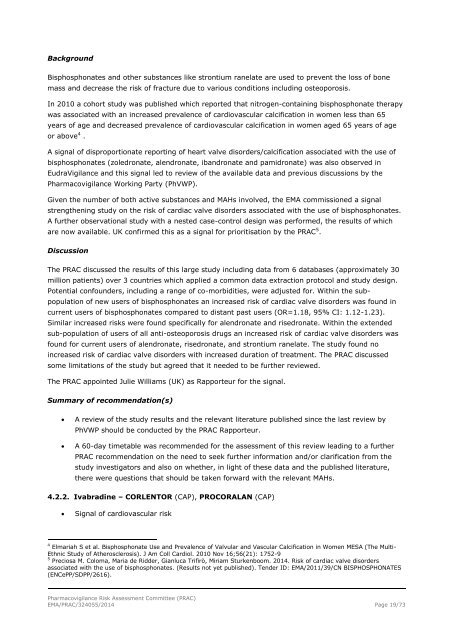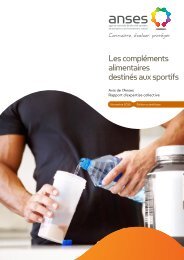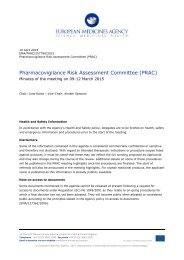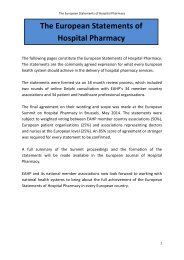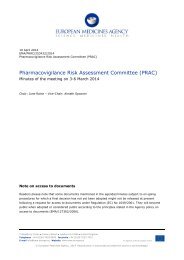WC500169468
WC500169468
WC500169468
Create successful ePaper yourself
Turn your PDF publications into a flip-book with our unique Google optimized e-Paper software.
Background<br />
Bisphosphonates and other substances like strontium ranelate are used to prevent the loss of bone<br />
mass and decrease the risk of fracture due to various conditions including osteoporosis.<br />
In 2010 a cohort study was published which reported that nitrogen-containing bisphosphonate therapy<br />
was associated with an increased prevalence of cardiovascular calcification in women less than 65<br />
years of age and decreased prevalence of cardiovascular calcification in women aged 65 years of age<br />
or above 4 .<br />
A signal of disproportionate reporting of heart valve disorders/calcification associated with the use of<br />
bisphosphonates (zoledronate, alendronate, ibandronate and pamidronate) was also observed in<br />
EudraVigilance and this signal led to review of the available data and previous discussions by the<br />
Pharmacovigilance Working Party (PhVWP).<br />
Given the number of both active substances and MAHs involved, the EMA commissioned a signal<br />
strengthening study on the risk of cardiac valve disorders associated with the use of bisphosphonates.<br />
A further observational study with a nested case-control design was performed, the results of which<br />
are now available. UK confirmed this as a signal for prioritisation by the PRAC 5 .<br />
Discussion<br />
The PRAC discussed the results of this large study including data from 6 databases (approximately 30<br />
million patients) over 3 countries which applied a common data extraction protocol and study design.<br />
Potential confounders, including a range of co-morbidities, were adjusted for. Within the subpopulation<br />
of new users of bisphosphonates an increased risk of cardiac valve disorders was found in<br />
current users of bisphosphonates compared to distant past users (OR=1.18, 95% CI: 1.12-1.23).<br />
Similar increased risks were found specifically for alendronate and risedronate. Within the extended<br />
sub-population of users of all anti-osteoporosis drugs an increased risk of cardiac valve disorders was<br />
found for current users of alendronate, risedronate, and strontium ranelate. The study found no<br />
increased risk of cardiac valve disorders with increased duration of treatment. The PRAC discussed<br />
some limitations of the study but agreed that it needed to be further reviewed.<br />
The PRAC appointed Julie Williams (UK) as Rapporteur for the signal.<br />
Summary of recommendation(s)<br />
<br />
<br />
A review of the study results and the relevant literature published since the last review by<br />
PhVWP should be conducted by the PRAC Rapporteur.<br />
A 60-day timetable was recommended for the assessment of this review leading to a further<br />
PRAC recommendation on the need to seek further information and/or clarification from the<br />
study investigators and also on whether, in light of these data and the published literature,<br />
there were questions that should be taken forward with the relevant MAHs.<br />
4.2.2. Ivabradine – CORLENTOR (CAP), PROCORALAN (CAP)<br />
<br />
Signal of cardiovascular risk<br />
4 Elmariah S et al. Bisphosphonate Use and Prevalence of Valvular and Vascular Calcification in Women MESA (The Multi-<br />
Ethnic Study of Atherosclerosis). J Am Coll Cardiol. 2010 Nov 16;56(21): 1752-9<br />
5 Preciosa M. Coloma, Maria de Ridder, Gianluca Trifirò, Miriam Sturkenboom. 2014. Risk of cardiac valve disorders<br />
associated with the use of bisphosphonates. (Results not yet published). Tender ID: EMA/2011/39/CN BISPHOSPHONATES<br />
(ENCePP/SDPP/2616).<br />
Pharmacovigilance Risk Assessment Committee (PRAC)<br />
EMA/PRAC/324055/2014 Page 19/73


